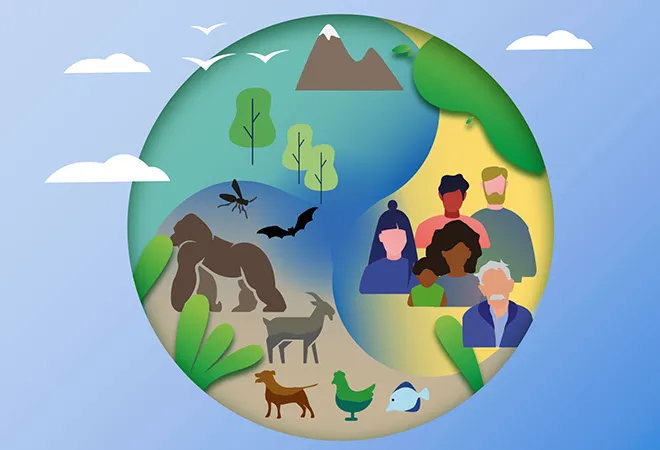-
CENTRES
Progammes & Centres
Location
The G20 has the potential to leverage its influence and resources to address the root causes of zoonotic diseases through joint initiatives and take preventative measures at a global scale

Zoonotic diseases, diseases that can be transmitted between animals and humans, pose a significant burden on global health. These diseases encompass a wide range of pathogens, including bacteria, viruses, and parasites, that can cause death in both humans and animals. Every year, 6 July is observed as “World Zoonoses Day”. This day aims to shed light on activities to raise awareness about zoonotic diseases and their prevention. It is estimated in the year 2017 that zoonoses are responsible for 2.5 billion cases and 2.7 million mortality rate worldwide. There are over 200 known types of zoonoses. According to estimates, around 70 percent of newly identified human diseases are zoonotic, meaning they originate from wildlife or spread through infection from domesticated animals. As the frequency of zoonotic outbreaks seems to be on the rise, it is essential to understand the factors that contribute to these outbreaks to effectively prevent the risks associated with zoonotic diseases. Given the scale of the problem, an intersectoral approach is needed to address the complex factors contributing to zoonotic disease transmission and emergence and their impact on human, animal, and environmental health,
Changes in temperature and precipitation patterns can alter the distribution and behaviour of vectors and reservoir hosts, leading to increased transmission of zoonotic pathogens.
The COVID-19 pandemic has emphasised the need for a more integrated and proactive approach to zoonoses prevention. Firstly, there is a need for improved risk communication and perception of the relevance of zoonotic diseases in community health. This involves effectively communicating information about zoonotic diseases to the public, raising awareness about the risks and preventive measures, and addressing misconceptions and misinformation. Secondly, climate change is increasing the risk of zoonotic diseases through various mechanisms. Changes in temperature and precipitation patterns can alter the distribution and behaviour of vectors and reservoir hosts, leading to increased transmission of zoonotic pathogens. Human activities that contribute to climate change, such as deforestation, create environments that are more favourable for the transmission of zoonotic diseases. Additionally, climate change can disrupt ecosystems and lead to changes in the interactions between hosts, vectors, and pathogens, increasing the likelihood of zoonotic spillover events. These factors, combined with the increasing global trade and human migration, contribute to the emergence and spread of zoonotic diseases. Thirdly, there is a need for the development and implementation of comprehensive policies and regulations.
The current global governance and surveillance structure for zoonoses prevention is fragmented and lacks coordination between organisations concerned with human, animal, and environmental health. This fragmentation has resulted in gaps in zoonoses prevention, leaving populations vulnerable to outbreaks of zoonotic diseases. To effectively prevent zoonoses, a multisectoral approach that involves collaboration between different stakeholders is necessary (Table 1)
Table 1: Recommendations to prevent zoonoses disease as per level of governance
| Micro Level | individual or community level | Promote good hygiene practices, such as handwashing, proper food handling and preparation |
| Safe disposal of animal waste | ||
| Education and awareness campaigns | ||
| Access to healthcare services and veterinary care -to detect and treat zoonotic diseases in a timely manner. | ||
| Meso Level | Organisations and institutions | Coordination and collaboration between different sectors- involvement of public health agencies, veterinary services, environmental agencies, and other relevant stakeholders. |
| Develop and implement surveillance systems for the early detection and monitoring of zoonotic diseases | ||
| Establish protocols for reporting and responding to outbreaks, as well as conducting research and sharing information on zoonotic diseases. | ||
| Macro level | National and international governance | Enact legislation and regulations to ensure the safety of food production and supply chains, as well as the welfare of animals. For instance, strengthening wildlife trade regulations to reduce the risk of zoonoses emergence. |
| Allocate resources for research, surveillance, and capacity building in zoonotic disease prevention and control | ||
| International cooperation and collaboration to address zoonotic diseases that transcend national borders. | ||
| Invest in research and development to advance scientific understanding of zoonotic diseases and develop innovative tools and strategies for prevention and control |
This approach recognises the interconnectedness of human, animal, and environmental health and involves collaboration between various sectors and stakeholders. For instance, on a global scale, World Health Organization (WHO) works closely with the Food and Agriculture Organization of the United Nations (FAO) and the World Organisation for Animal Health (OIE) on the Global Early Warning System for Major Animal Diseases (GLEWS). This collaborative system leverages the strengths of all three agencies to enhance early warning, prevention, and control of animal disease threats, including zoonoses. It achieves this through the sharing of data and conducting risk assessments to facilitate timely and coordinated responses. International conventions and treaties, such as the Convention on International Trade in Endangered Species (CITES) and the Convention on Biological Diversity, have played a crucial role in reducing the risk of zoonotic diseases by addressing key drivers of disease emergence, such as wildlife trade and habitat disruption. These conventions promote sustainable practices and regulations to mitigate the transmission of zoonotic pathogens. For example, CITES regulates the international trade of endangered species, including those that may carry zoonotic diseases. By controlling the trade of these species, CITES aims to reduce the risk of disease transmission to humans. Similarly, the Convention on Biological Diversity focuses on the conservation and sustainable use of biodiversity, which can help prevent the emergence and spread of zoonotic diseases. Collaborative networks and partnerships, such as the One Health Alliance of South Asia (OHASA), have been established to facilitate interdisciplinary approaches to prevent and control zoonotic diseases across South Asia regions. Global Health Security Agenda (GHSA) focuses on emerging zoonoses that threaten the global community. This collaborative effort aims to prevent, detect, and respond to emerging zoonotic disease outbreaks. The ongoing discussions on pandemic accord emphasise the member states’ commitment to enhancing “One Health” surveillance systems, laboratory capabilities, and overall coordination to mitigate the risks associated with zoonotic neglected tropical diseases and minimise the risks associated with pathogens and variants with pandemic potential. Whereas, at the national level, India has acknowledged the significance of the “One Health” approach. This approach highlights the interconnectedness of human, animal, and environmental health and promotes collaboration between different sectors to address zoonotic diseases. To strengthen the prevention and control of zoonotic diseases, India has launched the Inter-sectoral Coordination for Prevention and Control of Zoonotic Diseases programme. Additionally, India has developed the Roadmap to Combat Zoonoses in India (RCZI) initiative, which aims to identify and prioritise research options for controlling zoonoses in the country.
The Convention on Biological Diversity focuses on the conservation and sustainable use of biodiversity, which can help prevent the emergence and spread of zoonotic diseases.
In this context, the G20, which is a forum for the governments and central bank governors from 19 countries and the European Union (EU), can play a significant role in bringing together representatives from different sectors to foster collaboration and exchange of best practices in zoonoses prevention. The G20 has the potential to leverage its influence and resources to address the root causes of zoonotic diseases through joint initiatives, funding mechanisms, and policy frameworks. G20 can support the following areas. Such as
Despite the implementation of different measures and agreements, the current global governance structure for zoonoses prevention is fragmented. The G20 can play a crucial role in global endeavours to prevent zoonotic diseases by supporting efforts to strengthen surveillance systems, enhance research and development capacities, promote sustainable practices, and ensure the implementation of effective prevention and control measures on a global scale.
Viola Savy Dsouza is a PhD Scholar at Department of Health Policy, Prasanna School of Public Health.
Sanjay Pattanshetty, Head of the Department of Global Health Governance and Coordinator of Centre for Health Diplomacy, Prasanna School of Public Health
The views expressed above belong to the author(s). ORF research and analyses now available on Telegram! Click here to access our curated content — blogs, longforms and interviews.

Dr. Sanjay M Pattanshetty is Head of theDepartment of Global Health Governance Prasanna School of Public Health Manipal Academy of Higher Education (MAHE) Manipal Karnataka ...
Read More +
Miss. Viola Savy Dsouza is a PhD Scholar at Department of Health Policy Prasanna School of Public Health. She holds a Master of Science degree ...
Read More +